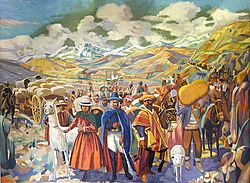Jujuy Exodus facts for kids

Portrait of the Jujuy Exodus.
|
|
| Date | August 23, 1812 |
|---|---|
| Location | From San Salvador de Jujuy to Tucumán |
| Participants | Population of San Salvador de Jujuy |
| Outcome | Attrition of the Royalist army led to its defeat at the Battle of Salta. |
The Jujuy Exodus (in Spanish, Éxodo Jujeño) was a very important event during the Argentine War of Independence. It was a huge movement of people from the Jujuy Province in Argentina. General Manuel Belgrano ordered this move. His patriot army was fighting against a Royalist army. The people had to leave their homes quickly, or they faced serious consequences.
Contents
Why the Exodus Happened
A Difficult Situation
In early 1812, General Manuel Belgrano had created the cockade and the Flag of Argentina. He was then told to move his army north. He took charge of the Army of the North in the city of San Salvador de Jujuy.
The situation was not good for the patriots. Before Belgrano arrived, another general, Juan José Castelli, had led a campaign into Upper Peru (today's Bolivia). Despite some early wins, Castelli's army was badly defeated at the Battle of Huaqui. The remaining patriot soldiers had to retreat to Jujuy.
Facing a Stronger Enemy
Belgrano's army was in a tough spot. They didn't have enough soldiers, weapons, or money. They were facing a victorious Royalist army that was much bigger and better armed. This Royalist army, led by General Pío Tristán, had about 3,000 soldiers. They were moving south from what is now Bolivia into northwest Argentina.
The patriot army was outnumbered two to one. Many soldiers felt discouraged. They were far from help from the government in Buenos Aires. Also, many people in Jujuy, especially the wealthy, didn't like the forces from Buenos Aires and were ready to switch sides. On top of all this, there was an outbreak of malaria (a serious illness) and no medicine.
Belgrano's Bold Plan
Scorched Earth Policy
General Belgrano knew his army might be completely defeated. To prevent the Royalists from getting supplies, he made a very difficult decision. He ordered everyone to pack only what they needed, like food and furniture. They had to leave with him, either in carriages or by walking. They also took all their cattle and other animals that could make the journey.
Everything else had to be burned. This included houses, crops, and food supplies. Even objects made of iron were to be destroyed. This strategy is called a "scorched earth" policy. It means destroying everything that could be useful to the enemy.
Joining the March
On July 29, 1812, Belgrano asked the people of Jujuy to "show their heroism." He urged them to join his army's march if they truly wanted to be free. He warned that anyone who ignored the order would face severe punishment, including execution and the destruction of their property.
However, Belgrano worked hard to get the people's support. He later reported that most people willingly followed him. They did not need to be forced.
The Exodus Journey
The Jujuy Exodus began on August 23, 1812. People from both Jujuy and Salta joined the march. They traveled south for about 250 kilometers (about 155 miles). In the early hours of August 29, they finally reached the banks of the Pasaje River in the province of Tucumán.
This brave act of the Jujuy people helped weaken the Royalist army. They couldn't find the supplies they needed. This played a big part in the Royalist defeat later at the Battle of Salta.
Remembering the Exodus
The Jujuy Exodus is still remembered today. In Jujuy, traditional groups hold an "Evocative March" every August 22. This tradition started in 1955. Since 2002, by national law 25.644, Jujuy Province is declared the honorary capital of Argentina every August 23.
See also
 In Spanish: Éxodo Jujeño para niños
In Spanish: Éxodo Jujeño para niños- Estadio 23 de Agosto

